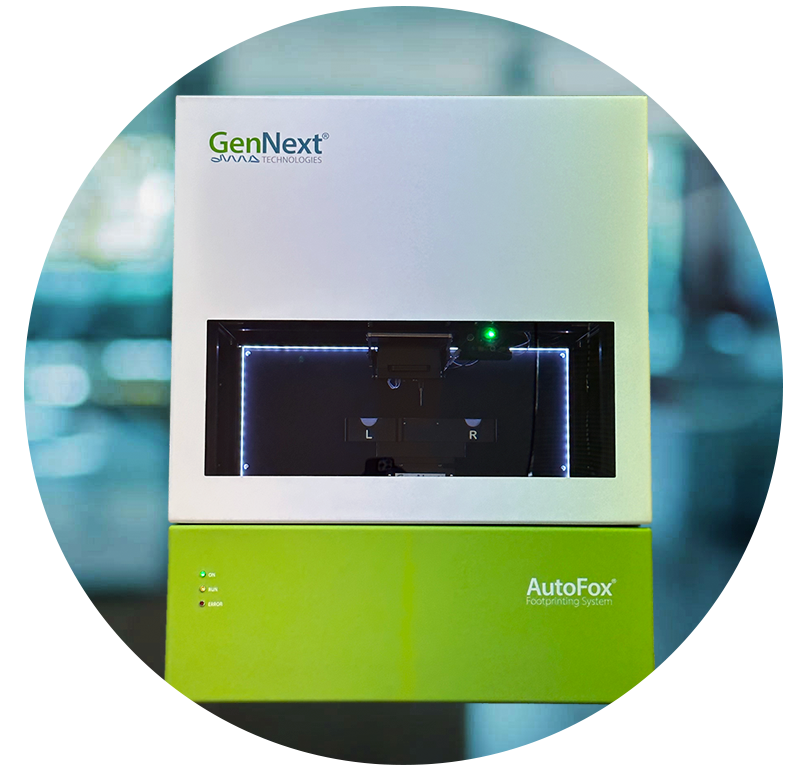Next Generation of
Structural Biology Research

Reinventing Protein Higher Order Structural Analysis via State-of-the-Art Protein Footprinting
Fox® Protein Footprinting Technology employs hydroxyl radicals (•OH) to examine the solvent accessibility of amino acid side chains within a protein. By selectively labeling exposed amino acids, •OH radicals induce the formation of oxidation products in exposed amino acids, enabling the detection and analysis of vital information concerning protein structure and dynamics.
Unlike other techniques, Fox Protein Footprinting delivers dynamic, in-solution structure and interaction information on a wide range of protein sizes, states, and concentrations.
Automated Radical Protein Footprinting, made possible by the AutoFox® System, delivers crucial HOS information that greatly influences the safety, efficacy, and quality of biologics.
Comprised of a user-friendly benchtop instrument coupled with intuitive data analysis software, the Fox platform makes it possible for biopharmaceutical researchers to easily and efficiently unravel the mysteries of protein HOS.
This powerful structural biology tool opens new doors to the understanding of proteins, accelerating advancements in biopharmaceutical research and development.
Direct Assessment of Solvent Accessibility
Higher-Order Structure Validation
High Spatial Resolution
Versatility Across Protein Classes
Complementary to Other Techniques
Protein-Protein Interactions
Epitope & Paratope Mapping
Protein-Ligand Interactions
Protein Folding & Conformational Changes
Regions Impacted by Allostery
Glycoprotein Structure & Function
- Small Molecule Therapeutic Target Engagement & Response
Rapidly Validate AI-Based Structural Models
Hands-Free, High-Throughput & Reproducible Labeling
First Fully-Automated Radical Protein Footprinting
With the launch of the AutoFox Protein Footprinting System, GenNext enables structural biology researchers to perform high-resolution protein footprinting studies with robustness, reproducibility, and ease—generating high-value structural insights in days instead of weeks or months.
GenNext’s FoxWare® Software removes data processing bottlenecks with this powerful program tailored to meet the demands of HOS analysis.
Learn how our products can easily fit into your lab’s workflow, or test-drive the Fox System on an outsourced project basis.

Structural Biology Services
Outsource Protein Footprinting Studies Starting Today!
Let the experienced GenNext research team generate high-value information on the characterization of your protein for more effective and safe biologics. Start a project today to study protein-protein interaction sites, epitope/paratope mapping, host antibody responses, antibody aggregation, and more.
Complement your traditional HOS methods or take a new route to modern HOS analysis. Use our contract research services to deliver actionable protein characterization data.
Applications from Discovery to Development
Insights from Biosimilars to AI Model Validation
Delivering HOS Answers in a New Way

The Fox Technology platform pairs an intuitive workflow with the robust FoxWare Protein Footprinting Software, producing results that rival even the most advanced, technically demanding, and expensive methods in structural biology. This integrated approach streamlines complex analyses, making top-tier structural data attainable for a wider range of laboratories. By minimizing operational complexity and lowering costs, the system empowers researchers to gain detailed insights into protein structures and dynamics with greater efficiency and ease than ever before.
See how the Fox platform stacks up against other protein HOS analysis methods.
GenNext News
Take a Deeper Dive
Why Partner with GenNext?
Hear from luminaries in structural biology research on why they decided to join the GenNext Technologies Scientific Advisory Board to help develop and advocate for Flash Oxidation (Fox) Hydroxyl Radical Protein Footprinting technology. These important partnerships underscore our commitment to advancing structural biology research and increasing the value of Fox technology to the biopharmaceutical industry.







